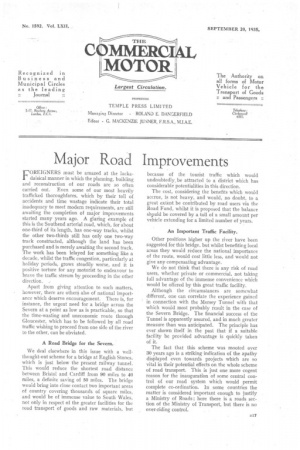Major Road Improvements
Page 35

If you've noticed an error in this article please click here to report it so we can fix it.
FOREIGNERS must be amazed at the la ckadaisical manner in which the planning, building and reconstruction of our roads are so often carried out. Even some of our most heavily trafficked thoroughfares, which by their toll of accidents and time wastage indicate their total inadequacy to meet modern requirements, are still awaiting the completion of major improvements started many years ago. A glaring example of this is the Southend arterial road, which, for about one-third of its length, has one-way tracks, whilst the other two-thirds still has only one two-way track constructed, although the land has been purchased and is merely awaiting the second track. The work has been lelayed for something like a decade, whilst the traffic congestion, particularly at holiday periods, grows steadily worse, and it is positive torture for any motorist to endeavour to brave the traffic stream by proceeding in the other direction. , Apart from giving attention to such matters, however, there are other also of national importance which deserve encouragement. There is, for instance, the urgent need for a bridge across the Severn at a point as low as is practicable, so that the time-wasting and uneconomic route through Gloucester, which has to be followed by all road traffic wishing to proceed from one side of the river to the other, can be obviated.
A Road Bridge for the Severn.
We deal elsewhere in this issue with a wellthought-out scheme for a bridge at English Stones, which is just below the present railway tunnel. This would reduce the shortest road distance between Bristol and Cardiff from 90 miles to 40 Miles, a definite saving of 50 miles. The bridge would bring into close contact two important areas of country covering thousands of square miles, and would be of immense value to South Wales, not only in respect of the greater facilities for the road transport of goods and raw materials, but because of the tourist traffic which would undoubtedly, be attracted to a district which has considerable potentialities in this direction.
The cost, considering the benefits which would accrue, is not heavy, and would, no doubt, to a great extent be contributed by road users via the Road Fund, whilst it is proposed that the balance shpuld be covered by a toll of a small amount per vehicle extending for a limited number of years.
An Important Traffic Facility.
Other positions higher up the river have been suggested for this bridge, but whilst benefiting local areas they would reduce the national importance of the route, would cost little less, and would not give any compensating advantage.
We do not think that there is any risk of road users, whether private or commercial, not taking full advantage of the immense convenience which would be offered by this great traffic facility.
Although the circumstances are somewhat different, one can correlate the experience gained in connection with the Mersey Tunnel with that which would most probably result in the case of the Severn Bridge. The financial success of the Tunnel is apparently assured, and in much greater measure than was anticipated. The principle has ever shown itself in the past that if a suitable facility be provided advantage is quickly taken of it.
The fact that this scheme was mooted over 30 years ago is a striking indication of the apathy displayed even towards projects which are so vital in their potential effects on the whole scheme of road transport. This is just one more cogent reason for the inauguration of some central control of our road system which would permit complete co-ordination. In some countries the matter is considered important enough to justify a Ministry of Roads ; here there is a roads section of the Ministry of Transport, but there is no over-riding control.




































































































